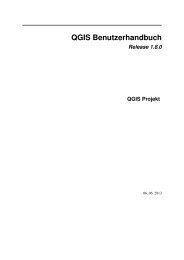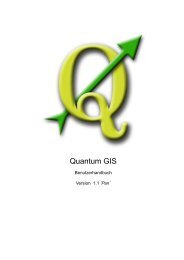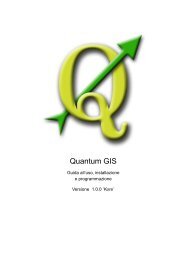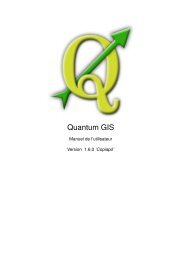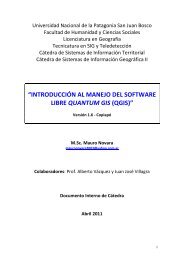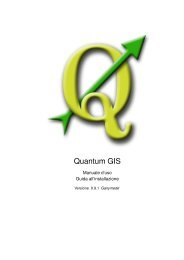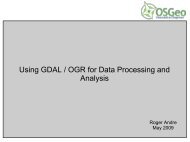QGIS User Guide - OSGeo Download Server
QGIS User Guide - OSGeo Download Server
QGIS User Guide - OSGeo Download Server
You also want an ePaper? Increase the reach of your titles
YUMPU automatically turns print PDFs into web optimized ePapers that Google loves.
12 USO DEI PLUGIN CORE <strong>QGIS</strong><br />
<strong>Download</strong> OSM data is used to download data from the OpenStreetMap server.<br />
Upload OSM data is used to upload changes (on current data).<br />
Import data from a layer is used to import data from a vector layer. At least one vector layer<br />
must be loaded and current OSM data must be selected.<br />
Save OSM to file is used to save OSM data back to an XML file.<br />
More detailed information on all the widgets, buttons and dialogs can be found in appropriate sections<br />
of this plugin section according to their functionality (editing, identification, etc.).<br />
12.14.3. Loading OSM data<br />
The first action that should be done after starting the OSM Plugin is opening data from an OSM file.<br />
OSM data can be import as shapefile or downloaded directly from the OpenStreetMap server. Here<br />
we are focusing on the first mentioned method.<br />
To load data from a file use the Load OSM from file icon. If there is no such button, maybe<br />
someone disabled OpenStreetMap toolbar in your <strong>QGIS</strong> instalation. You can enable it again selecting<br />
Settings > Toolbars > OpenStreetMap .<br />
Purpose of its elements is explained below.<br />
OpenStreetMap file to load: Click on the button to select the .osm file you want to load data from.<br />
Add columns for tags: This option determines a connection between OSM and <strong>QGIS</strong> data. Each<br />
feature of OSM data has some tags (pairs of key and value), that define the feature properties.<br />
Each feature of a <strong>QGIS</strong> vector layer also has its attributes (key and value). With this option<br />
you can define which properties of OSM objects should be visible when displaying detailed<br />
information about <strong>QGIS</strong> features.<br />
Replace current data: Checking this option means that new data should replace current data the<br />
user is working with. Layers of current data will be removed and new ones will be loaded. When<br />
loading OSM data for the first time, this option is not active, because there is nothing to replace.<br />
Use custom renderer: This option determines how many details of the map will be used. There are<br />
three pre-defined OSM styles for map displaying. Use Small scale if you want to view OSM<br />
data at low level, to see all details and to edit something. If not you can use Medium scale or<br />
Large scale . <strong>QGIS</strong> 1.4.0 doesn’t support changing the renderer style dynamically.<br />
<strong>QGIS</strong> 1.4.0 <strong>User</strong> <strong>Guide</strong> 190



